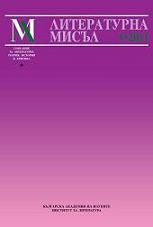Литературни преливания
Literary transfusion
Author(s): Alexander ShurbanovSubject(s): Literary Texts
Published by: Институт за литература - БАН
Keywords: Literary transfusion; Analogies between literary works
Summary/Abstract: This essay deals with a variety of intriguing analogies between literary works that can hardly be ascribed to intertextual contact. It starts with more obvious cases of continuity within a national tradition, such as Hristo Botev’s re-writing of Georgi S. Rakovski’s revolutionary poems in late nineteenth century Bulgaria, resulting in the creation of indisputable lyrical masterpieces that have completely obliterated their connection to their antecedents. A similar example of, most probably, conscious or semi-conscious borrowing – across national borders – is then adduced from the parallel between Reiner Maria Rilke’s “Der Panther” and Ted Hughes’s “The Jaguar”, the two poems appearing to be involved in a debate almost as companion pieces. Further, the survey returns to Botev’s poetry to detect in it motifs and images existing in Caucasian folklore and in Percy Bysshe Shelley’s elegy “Adonis”, both of which are highly unlikely to have been familiar to the Bulgarian poet. What comes next is a set of intricate analogies between Shakespeare’s tragedy King Lear and Elin Pelin’s novel The Geraks (Гераците) on the levels of ideas, plot, characters and atmosphere, suggesting direct indebteness, which has however never been acknowledged by the Bulgarian author and is generally difficult to maintain. Another, even more complex and puzzling web of resemblances is found between Dimcho Debelyanov’s poem “Homecoming” („Да се завърнеш в бащината къща“), Sergey Esenin’s lyrical piece “Pismo materi”, and John Updike’s novel Of the Farm. Then we turn to the vexed question of the Bulgarian origins of Shakespeare’s late dramatic romance, The Tempest, in order to examine the evidence of medieval Balkan chronicles and their traces in Italian and Spanish Renaissance publications which might have come to the notice of the English playwright – a possibility that remains elusive yet irrefutable. Finally, the avatars of a poetic image of symbolic potential, that of children playing on the seashore, is traced through Rabindranath Tagore’s poem № 60 in his Nobel prize winning collection Gitandjali, William Wordsworth’s “Ode: Intimations of Immortality”, and Blaga Dimitrova’s “Child and Sea” („Дете и море“). The conclusion that can be drawn from this alarmingly varied picture of intertextuality is a reminder that the individual literary works are not watertight entities and that they participate in an endless worldwide exchange of ideas and motifs, which is not necessarily conscious but can ultimately be explained by reference to the oneness of all literature.
Journal: Литературна мисъл
- Issue Year: 2011
- Issue No: 1
- Page Range: 119-150
- Page Count: 31
- Language: Bulgarian
- Content File-PDF

